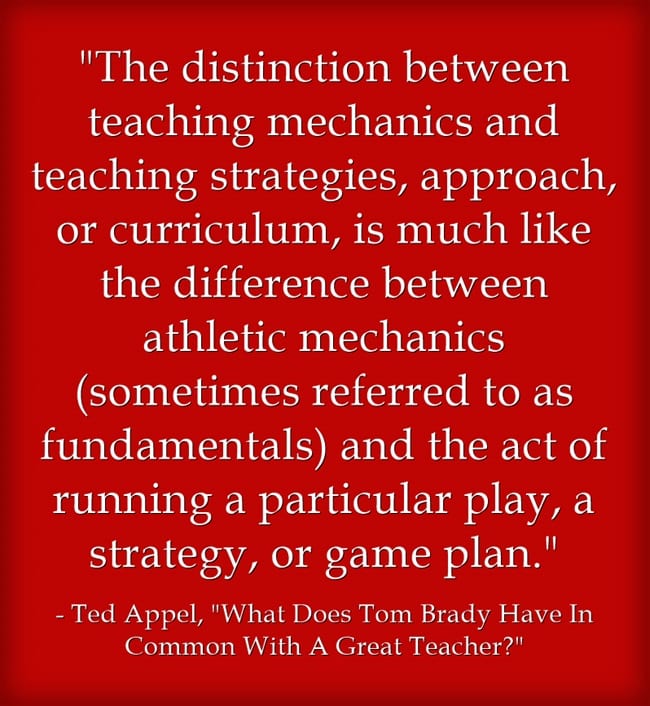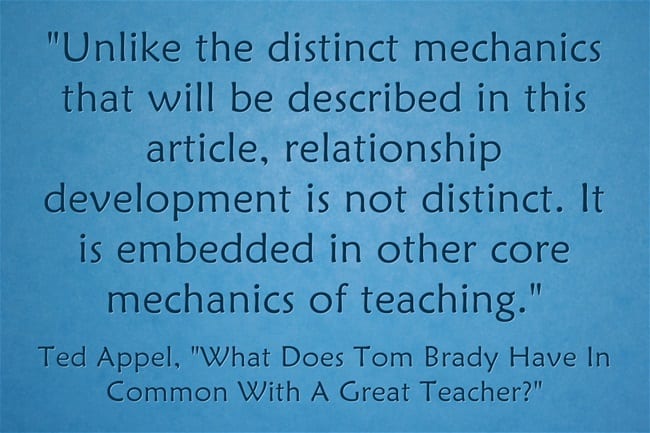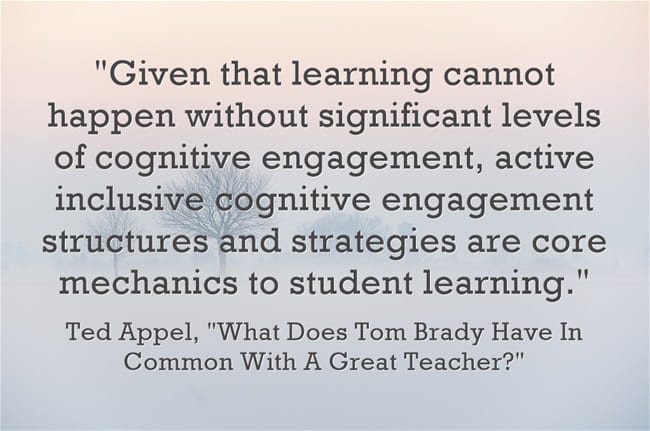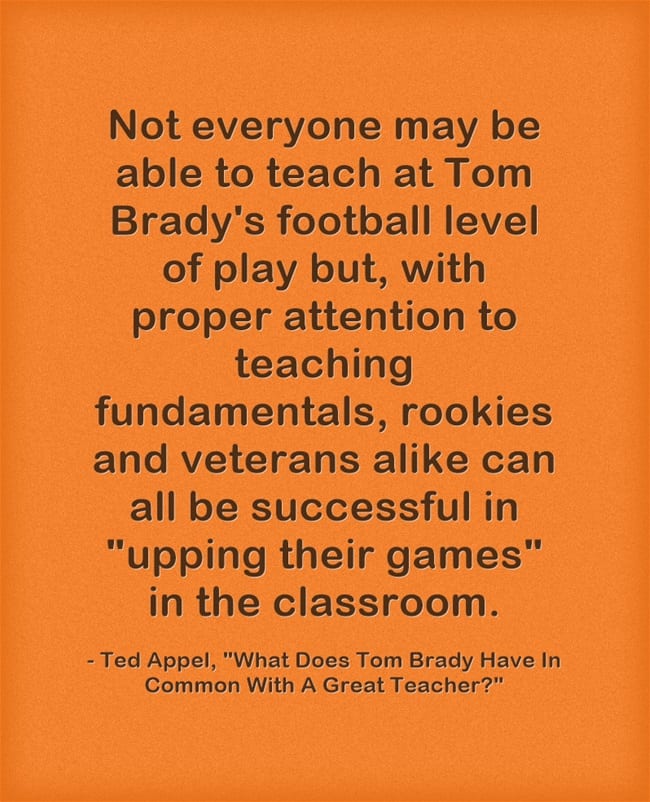Tom Brady may or may not have announced his retirement from pro football today.
I thought it might be appropriate to republish a previous post headlined “What Does Tom Brady Have In Common With A Great Teacher?”
It was later later republished in The Washington Post.
Editor’s Note: I know of no one who is a better thinker about education than Ted Appel, the former principal at our high school. Unfortunately, he seldom succumbs to my pleading to put his thoughts on paper. I, like most of America, root against Tom Brady and the New English Patriots whenever possible, but I am happy that he inspired Ted to write this important piece….
Ted Appel has spent forty years in education as an Outward Bound instructor, social science and special education teacher, teacher coach and most recently as the Principal of Luther Burbank in Sacramento.
Over the weekend, while watching veteran future Hall-of-Famer Tom Brady complete his seventh pass in a row, as the New England Patriots defeated the “Los Angeles” Chargers, I was taken by a remark made by one of the announcers, former quarterback Tony Romo. He said, in preparation during the week leading up to the playoff game, Tom Brady worked with his personal coach to “refine his mechanics.” Tony Romo then went on to comment on how precisely Brady’s footwork was on drop backs, how solid his posture was in the pocket, how evident his scan of the field was before he decided where to throw, the crisp velocity and accuracy of his short passes, and his textbook form on his longer throws. While the Patriots had a solid game plan and ran the right plays, the key to the game was Tom Brady’s sound mechanics and consequent perfect execution.
As a former teacher coach and high school principal, I have always believed instructional mechanics are fundamental and critical to successful teaching. Too often, schools, districts, teacher preparation programs and the whole education industrial complex ignore teacher mechanics in favor of curriculum, content based teaching strategies, and structures that are far easier, and perhaps more interesting, to address than the basic foundational mechanics of good teaching.
The distinction between teaching mechanics and teaching strategies, approach, or curriculum, is much like the difference between athletic mechanics (sometimes referred to as fundamentals) and the act of running a particular play, a strategy, or game plan. Athletes understand that in order to succeed they must execute certain basic core skills no matter the play or plan. No athlete or team will succeed without each athlete consistently executing basic blocks, routes, throws, strokes, catches, or slides. No degree of creativity or innovation can overcome the need for the mechanical skill necessary to carry out a plan. Similarly, no lesson plan, teaching strategy, or curricular approach can succeed without a teacher exercising the core skills that go toward making a plan work.
What are the fundamental mechanics of classroom teaching? They are distinguished from instructional strategies or curriculum in that they are the required backdrops present for all lessons to be effectively taught. This also includes the overarching necessity for the continuous development of educational relationships with all students. Unlike the distinct mechanics that will be described in this article, relationship development is not distinct. It is embedded in other core mechanics of teaching. This can be attributed to the fact that a central characteristic of teacher-student educational relationships is the confidence and belief held by students that they would be able to learn and succeed with the individual teacher. There are many aspects to building that confidence, particularly with students who have low confidence in their ability to achieve in the first place.
A particular challenge is to help a student to believe the teacher understands and can relate to student and their challenges in some way. That confidence is built through many teacher interactions with their students, but an ongoing feature of building student confidence is the existence of consistent attention to core mechanics, which create order, structure, opportunity and relevance to all activities in a class. Much as it is critical that Tom Brady’s teammates believe that if they do what is being asked, the quarterback has the mechanical skill to deliver, so too are students impacted by their trust that their teacher has the skill to construct an environment conducive to their learning success. Belief, trust, and confidence are central parts of an educational relationship that can be built through strong classroom teaching mechanics.
The biggest challenge is people would rather work on strategies and curriculum. It is always more interesting than attending to the basics. Revisiting the athletic analogy, who wants to work on footwork, basic ball handling, or shooting mechanics drills? Of course, we don’t have the luxury of separate practice time. But, we do play a lot of games (actual classes). Teachers need to be encouraged to turn classes into practice games for fundamentals. Video themselves, ask colleagues to observe for five or ten minutes, reflect on what they are doing or not doing mechanically. Administrators need to emphasize it, reinforce it, and keep it front and center.
Here I identify four areas of mechanics that need to be addressed for any lesson taught. There are a variety of ways the mechanic can be addressed. What’s important is the foundational structure is addressed in a manner that accomplishes its intent.
Lesson Plan Mechanics (Intentional interactions between teacher, students and learning activity designed for particular purpose(s))
All teachers who have been through a teacher preparation program are familiar with any number of lesson plan structures and templates. They usually include phrases like objective(s), materials needed, checks for understanding, standards being addressed etc. Often, these ritualized lesson plans become perfunctory required acts divorced from any meaningful guide to the intentions of learning activities or teacher actions during a class period. The mechanics of lesson planning involves the dynamic reflection of the congruence between the intent of every aspect of interactions between the teacher and students or the students and the learning activities of the class. Attention to the mechanics of lesson planning involves observation and questioning, internal and external to examine if and to what degree lesson intent and lesson implementation are aligned as written and to what is actually taking place in a classroom. Monitoring of this mechanic should take place speculatively and dynamically as implementation is taking place. Ideally, every action in a class should be intentional, and upon review, the action and intention should at all times be ideally aligned. This reflective practice is dynamic and is one of the aspects of teaching that always keeps it fresh, exciting and challenging.
Examples:
- Go over the answers to homework questions. (Why? What is the learning intent if students have already done the cognitive work? How will learning be extended by this exercise?)
- In groups of 4 students will identify the theme of a passage and find supporting quotes for their answer. (Why groups? Why 4? What is the learning intent of students in a group rather than each student individually engaging in the exercise?)
Classroom Management Mechanics (Classroom structures and interactions likely to create a safe, orderly and conducive environment for learning)
No other aspect of teaching requires as much attention to mechanics as classroom management. Too often, core classroom management mechanics are perceived to be external to the actual craft of teaching. Teachers generally attend to these mechanics when they first start teaching or just at the beginning of a school year or semester. Simple classroom management basics, for example, insists on total compliance for attention before giving direction gives way to a rush to complete a given task or activity. Similarly, simple mechanics such as use of proximity, consistent routines and procedures, and concrete reinforcement of productive behavior all enhance learning relationships and confidence. Nothing upsets the orderliness and diminishes student confidence in a teacher quicker than the loss of strong classroom management mechanics. Ironically, the erosion of classroom management discipline for the sake of lesson efficiency results in the exact opposite effect.
Here are a few examples of classroom management fundamentals:
- consistent routines and procedures
Examples of important routines and procedures include walk in expectations, seating arrangements, transition procedures, end of class routines.
- use of proximity
Room arrangements conducive to teacher access to all students, teacher attending to students vulnerable to distraction through physical presence.
- wait time and monitoring for full compliance
Consistently refraining from “talking over students”. Conveying conviction regarding directions or tasks by committing to 100% compliance.
- concrete reinforcement of productive behavior
creating a positive “feeling tone” in a classroom by making concrete comments affirming positive behavior. Avoid generic and often meaningless “good job” in favor of “you arranged the papers exactly as the directions on the board said.”
Actively Inclusive Cognitive Engagement Mechanics
All students should be cognitively engaged in all learning activities 100% of the time. This is certainly a lofty and yet unrealistic expectation, similar to believing a quarterback can complete 100% of their passes or a batter will get a hit 100% of the time. A quarterback and a hitter don’t approach a throw or at bat unprepared to succeed. Athletes continuously strive to be perfect 100% of the time. Failures are analyzed for what could have been done better or differently to improve the likelihood of success. Implementation of core mechanics of the skill being practiced is an essential element to that analysis. Given that ongoing cognitive engagement is core to student learning, the mechanics of increasing the probability of all being cognitively engaged should be consistently attended to, analyzed, and implemented at the highest level that can be controlled. Without consistent attention, habits of active, or more often passive, cognitive exclusion results. Given that learning cannot happen without significant levels of cognitive engagement, active inclusive cognitive engagement structures and strategies are core mechanics to student learning. The means for achieving the mechanics of active cognitive engagement are extensive but attention can be focused into three areas:
- Overt all class participation
What is the teacher doing to ensure all students have opportunities to express cognitive processing which demonstrates their cognitive engagement? Examples may include all student written responses, oral choral responses or physical displays. Key is all students have consistent opportunities to express their engagement for all content material.
- Covert all class participation
What is the teacher doing to ensure students have opportunities to engage privately with content material? Examples may include asking students to mentally calculate, imagine, picture or mentally rehearse. This may be a precursor to overt expression or in some circumstances stand-alone.
- Motivation mechanics (time, amount of work, degree public)
What is the teacher doing to increase the likelihood of students cognitively engaging in overt and covert learning opportunities and activities? Examples such as limiting time and the amount of work (commonly referred to as chunking), raising or lowering the student level of concern (high stakes or low stakes) relevance, and other intrinsic factors.
Ongoing Formative Assessment Mechanics (consistent real time observation and evaluation of what is understood)
There are many ways teachers can formatively assess students. All systems need to ensure the core intent of formative assessment is maintained. The formative assessment being used needs to incorporate monitoring for participation and compliance, monitoring for the collection of information from a broad cross-section of the class, and mechanisms for providing immediate feedback or redirection to maximize the learning impact of a learning activity or learning direction. There is a broad array of ways in which teacher can formatively assess students as any check for understanding is a formative assessment. Other common forms include:
- Listening to choral responses in which the teacher monitors for compliance. The teacher is observing and listening carefully to determine confidence, fluency, and correctness. The teacher is responsive to what they hear or see.
- A quick visual scan of a class to observe compliance, a purposeful examination of a select cross-section of students to observe what is understood and what is not. And providing feedback or further instruction / clarification based on what was observed. (It is critical that this does not become a “teach and tutor” session where the teacher ends up re-teaching the lesson to one or two students while the rest of the class waits or goes off task.)
- Observing choral physical responses monitoring for compliance, collecting information on common strengths or areas of improvement, and providing new demonstrations based on the information gathered.
As is true with the mechanics of playing quarterback, in which there may be differences in the style with which they are executed, teaching mechanics can be exercised in a variety of ways. It is essential to understand that mechanics are what a play or lesson are built upon. There may be differences in the mechanics necessary for a given action. For example, the mechanics for a drop-back pass are different than for that of a rollout or play action, but each has a mechanical foundation upon which it is based. Attention must be paid to that mechanical foundation for anything else to work. A discovery lesson may require a very different mechanical foundation to achieve the classroom environment necessary for productive learning to take place than a highly structured teacher centered lesson. It may be appropriate for the students to establish procedures and guidelines for learning themselves. Nevertheless, implementing structure for the fundamental need is still required.
Not everyone may be able to teach at Tom Brady’s football level of play but, with proper attention to teaching fundamentals, rookies and veterans alike can all be successful in “upping their games” in the classroom.








Recent Comments